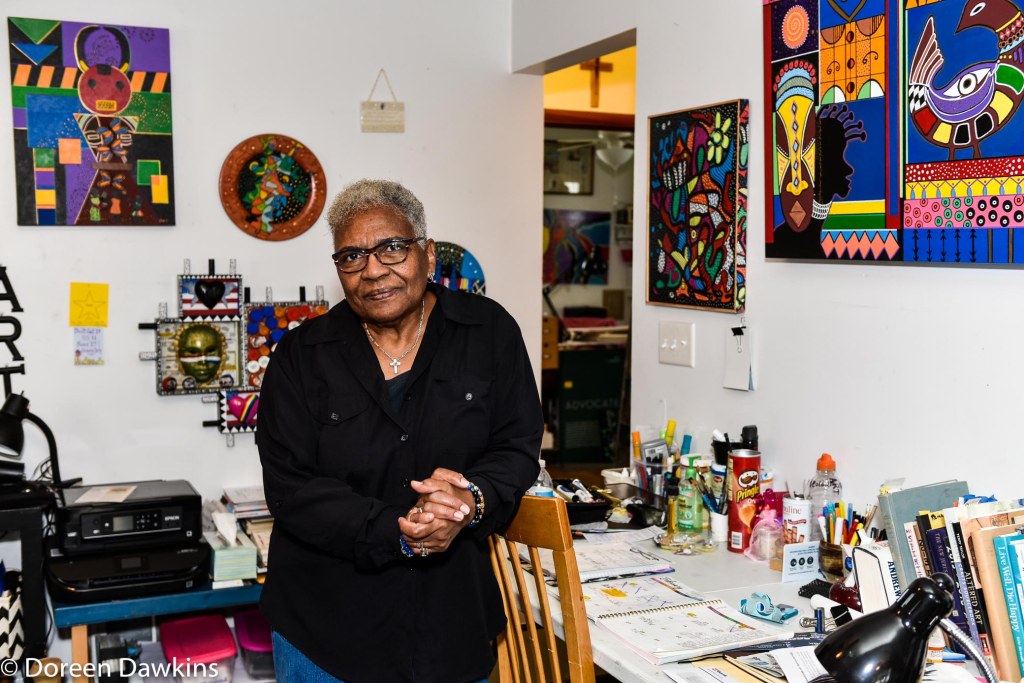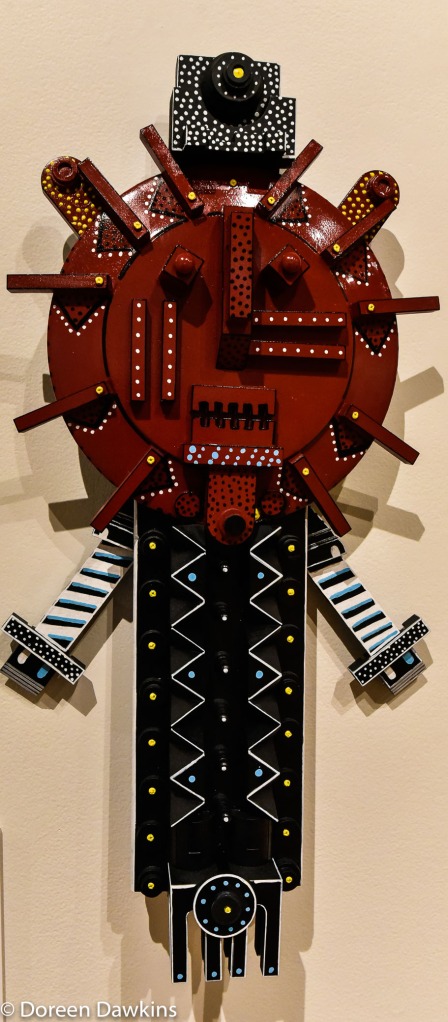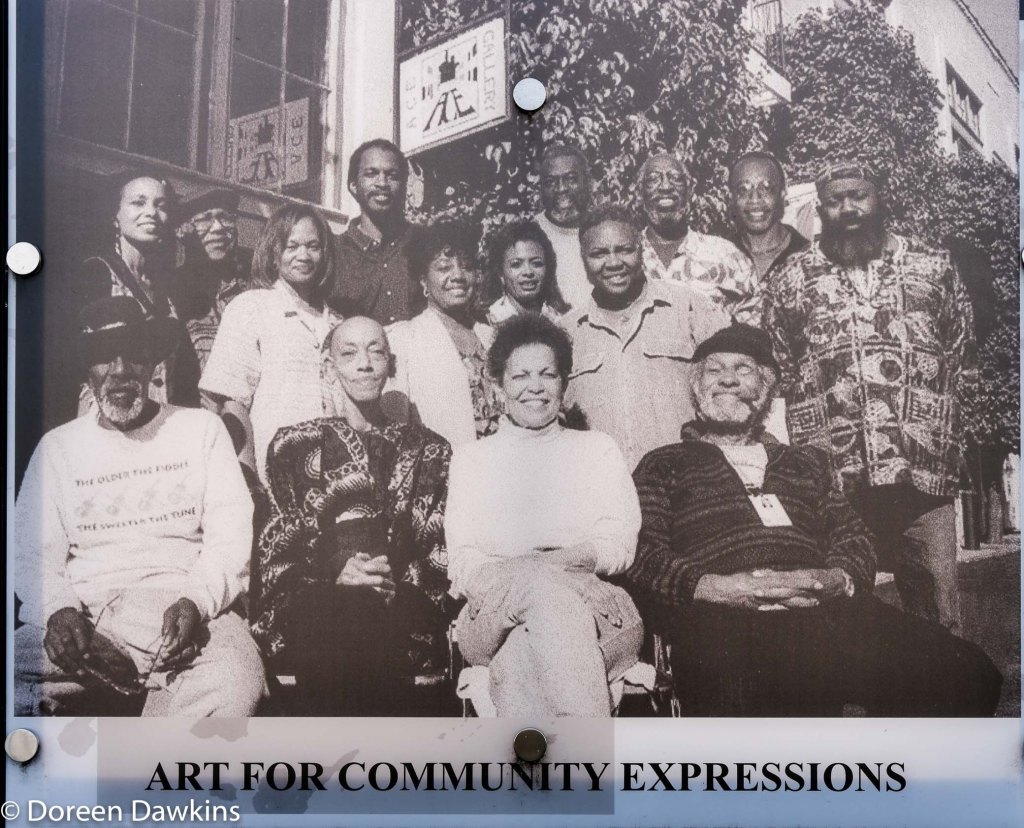Location: Blue Haven Art Studio, 462 S. Waverly St. Columbus, OH 43213

Tell me about your art and how it has evolved over time. How would you describe what you do?
I started out as a photographer. I did photography for many years. I started taking photographs with the idea that I would make them into a painting or drawing. I was not interested in events or weddings. When I did photography, I wanted it to be different. I started to incorporate other media into my photographs. I didn’t know that it might be considered mixed media at the time. I colored my photographs. I cut them up and I wove them together. I sepia toned a lot of them. I enjoyed taking black and white photographs. I enjoyed taking candid photographs, where people were not aware or posed. I took photographs of abstract things. I made photograms. I would go into the dark room and place objects on the paper then expose that to light, expose it to the chemicals and the shadows and shapes would come out. After several years, I got tired of it. Now, I am a mixed media artist.
I started to do paintings and drawings when I got a job teaching as an art instructor at the J Ashburn Junior Youth Center on the West Side, teaching children how to draw, paint, and use clay. From painting and drawing, my art evolved to wood burning. The wood burning came about because the kids received gifts of wood burning tools. The kids were afraid of the tools. The older kids who could use the gifts preferred to be in the gym instead of the art room. I started to use the wood burning tools. It is called pyrography. Then, I started to hand color the wood burnings. I think I like to color within lines because I colored coloring books as a kid. I still love to color inside the lines. I might like to make crooked lines, but I like coloring inside them. I got tired of the wood burning and I went on to the mixed media.
I don’t know what I am going to do when I get tired of mixed media.

“Mother Earth Matters.” and “Tribute to the Lessor God” are part of Ohio Diaspora at the Riffe Gallery. Tell me about “Mother Earth Matters.”
I like working with circles. The circle is a symbol with many connotations, such as unity, completeness, sacredness and eternity. I started out painting this piece and adding things to it. I work by intuition. I don’t sketch anything out. As the piece evolved, it got to be more Native American. When I think of Native Americans, I think of their love of the earth. I started to look for Native American symbols. I started to look for leather. The piece also speaks to our need to love what God has given us and what God has put us in charge of. I like for my work to speak to those things that we need to think about.

Tell me about “Tribute to the Lessor God”.
I completed a painting on this figure for a show. The inspiration was inspired by an African American artist (Lois Mailou Jones, Guli Mask (1972)). I researched the African Mask. It is a West African mask that the dancer wears. The dancer comes out first and precedes all the other gods. I thought, this is the lessor god.
I love putting things together. It’s called an assemblage. When you add things that are not a part of the wood, it becomes mixed media. I wanted to create from the painting I completed. People seem to like that piece a lot more than it appeals to me.
Sidebar: Any god other than God will not be capitalized on my blog.

Tell me about your mentors.
Kojo Kamau (1939-2016) and Barbara Chavous (1936-2008) were my mentors. I don’t think they had any intention on being my mentors or realized they were my mentors. They taught me by allowing me to observe and answer my questions. They gave out information because they felt they could trust me with that information.
When I worked for COTA, I got hit in the back with a railroad tie. I was in the bed for a couple of years. I saw an article on Kojo. I thought, wow a black photographer. That is when I started thinking about being a photographer. I decided I was tired of being in the bed, tired of being in the house, and tired of being in that condition. I went to Kojo’s gallery. I was in my late 30s and had never been to an art gallery or museum. I went up and looked in his window and looked at his photographs and African artifacts. I was overwhelmed with joy. And then I went home. The next day, I went back. I looked in the window, then I went home. The next day, I went back and this sounds crazy, but I did the same thing. Finally, Kojo came out and said, “When are you going to come in.” I said, “I don’t have any money.” He said, “You don’t have to have money to walk in a gallery.” I said, “You don’t?” He said, “No”. That opened the door of God’s journey for me. I never went outside that door again. I determined that I wanted to be an artist and I didn’t look to do anything else. I didn’t look at any other jobs unless they had something to do with being creative.
Kojo hired me to work for him. He taught me how to work in the dark room. Most of all, I was the receptionist at Kojo’s photo art studio which was located at 90 North Washington. It is gone now.
Was that ACE gallery?
That is where ACE gallery was created.
I met all the black artists that were claiming to be artists. That was the only place we had to go. He gave me my first show. He said, “Nobody is going to buy that stuff.” He was trying to help me become an event and wedding artist because he felt that is where I could make some money. I sold out the whole show. The first piece I sold was to another artist named Smokey Brown (1919-2005).

I stayed there as a receptionist and assistant. I met all the artists at the time. That is how I met my other mentor, Barbara Chavous (1939-2016). She was friendly, open and feisty. She had the kind of personality that she loved everybody. She believed everyone was good until they did something wrong to her.
The first time I saw her work, I thought, “I don’t know what this is.” I was totally puzzled. I looked at the work, then I looked at the people enjoying the work. I said to myself, “Ok you don’t know what this is about. You need to learn what it is about.” I went up to her and asked if I could come to her studio to talk about her work. She pulled out an appointment book. I thought, “She is really important.” She gave me an appointment and I made sure I went.
Her studio was in her home on Franklin Ave. It is still there. Her son has it. She made 15-foot totems. They fit in her living room with much room to spare. That is how high her ceilings were. She let me take so many pictures of her. She was the first person that told me I am an artist.

Ursel White Lewis (1913 – 2008) was an art patron. She was a regal black woman. She wore white gloves and a hat all the time. She wore tailored suits. She got Aminah (Robinson) started. She was also a friend of Kojo’s. She came in the gallery. She knew about art from A to Z. She knew white artists, black artists and art history. She would buy people’s art and donate it to the museum. She said she did that because that was the only way black artists were going to get in the museum because the museum isn’t going to buy it. She also encouraged me. She said, “You are an artist. Just keep doing what you are meant to do.”
She was fantastic and very vain. As she got older, she stopped coming out. She couldn’t see. She didn’t want to be seen in any way other than how she had presented herself. I admire her for that. I’m like that too. I don’t want to be out there ugly.

Tell me about the two pictures you are posing with.
The first picture is a wood burning. The name of it is “Going Home”. I completed it in 1990. Kojo bought it for his wife. A few weeks later, his wife passed. He kept the piece and it was given to me after he passed.
Explain the theme “Going Home.”
It is about the resurrection. A lot of my work tends to be spiritual. I am trying to appeal to someone. I don’t care if I don’t appeal to everyone. Usually, I am trying to say something. If someone gets it, then it was meant for them to get it. I am trying to get you to look and think about how we are to treat ourselves and each other. Also, to think how we are to reverence the God that brought us here. I don’t draw anything realistic. I can do it, but it is a task for me. Give me symbols, lines, and colors. My challenge is to put them together, so they have meaning for me first, then someone else.
The second is based on a photograph of Barbara Chavous that was taken many years ago. In 2016, I took her image out of the photograph, then I painted around her image. I added decorative elements and the pyramids. I put a shawl on her, because in the original photograph, she had her ex-husbands arm around her.
She had parties at her house all the time for artists. It was the first place that I learned how to eat raw vegetables and cheese and drink wine. She would try to make sure everyone enjoyed themselves. If we went for a walk and saw homeless people, she would say, “Isn’t she beautiful?” I would say to myself, “How?” She would say “She put those colors together.” She saw everything in terms of art. I learned to appreciate those things in people. At first, I didn’t understand what she was talking about. If you hang around people who see life in a positive way, it becomes a part of you. The same with negative people. Avoid them at all costs. Negative people are not happy people. If you did something that she didn’t think was right, she didn’t hold back. She would tell you flat out. She was completely honest.
How do you/did you improve?
I went back to school after I was an established artist to get credentials. When God gives you raw talent and you start to see more that can be associated with that talent, we must do as much as we can with that talent. God gives us the resources. I didn’t even know you could go to college for art. The first time I went to college, I went for Elementary education. Then, I went back for social work. I didn’t like either one of them. What having credentials at the time for me meant that I could teach at the college level. I did that. When I pursued my Bachelor of Fine Arts, I took out loans and paid them back. When I pursued my master’s degree, I had grants, I didn’t have to pay back anything. I saw young people waiting in line to complete applications for grants and scholarships. They would get impatient and get out of line. In my mind I would think, “Thank you Jesus that is one step forward. One more person I didn’t have to wait for.” I learned that you must be patient for the things that matter to you. The things that you want aren’t always going to come easy. Sometimes they do, but most often they don’t. There are always opportunities for learning. As old as I am, I learn from some of the young people. What they know and I don’t know, I don’t have a problem asking.

Why did you buy the picture that you are posing with?
Because I didn’t want anyone else to buy it.
Why?
Because I didn’t want anyone else to have my picture.
Sidebar: Vanity, vanity all is vanity.
Queen Brooks: “Sidebar God knows it and I admit it.”
Sidebar: For the record I think that is the first time that anyone has commented on my sidebar.
You mentioned that much of your work is not currently in your gallery because something is going on in April. Where is it?
It is at the Southern Ohio Museum in Portsmouth, Ohio. It opens April 25, 2020. I also have some work at McConnell Art Center.